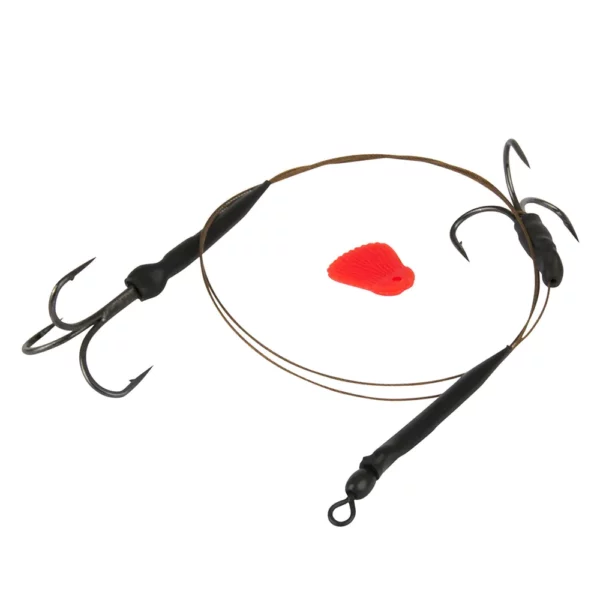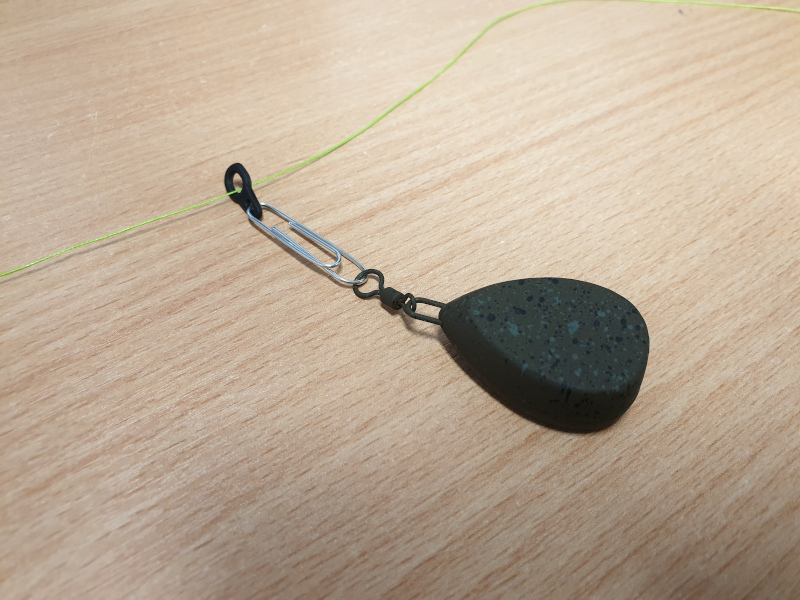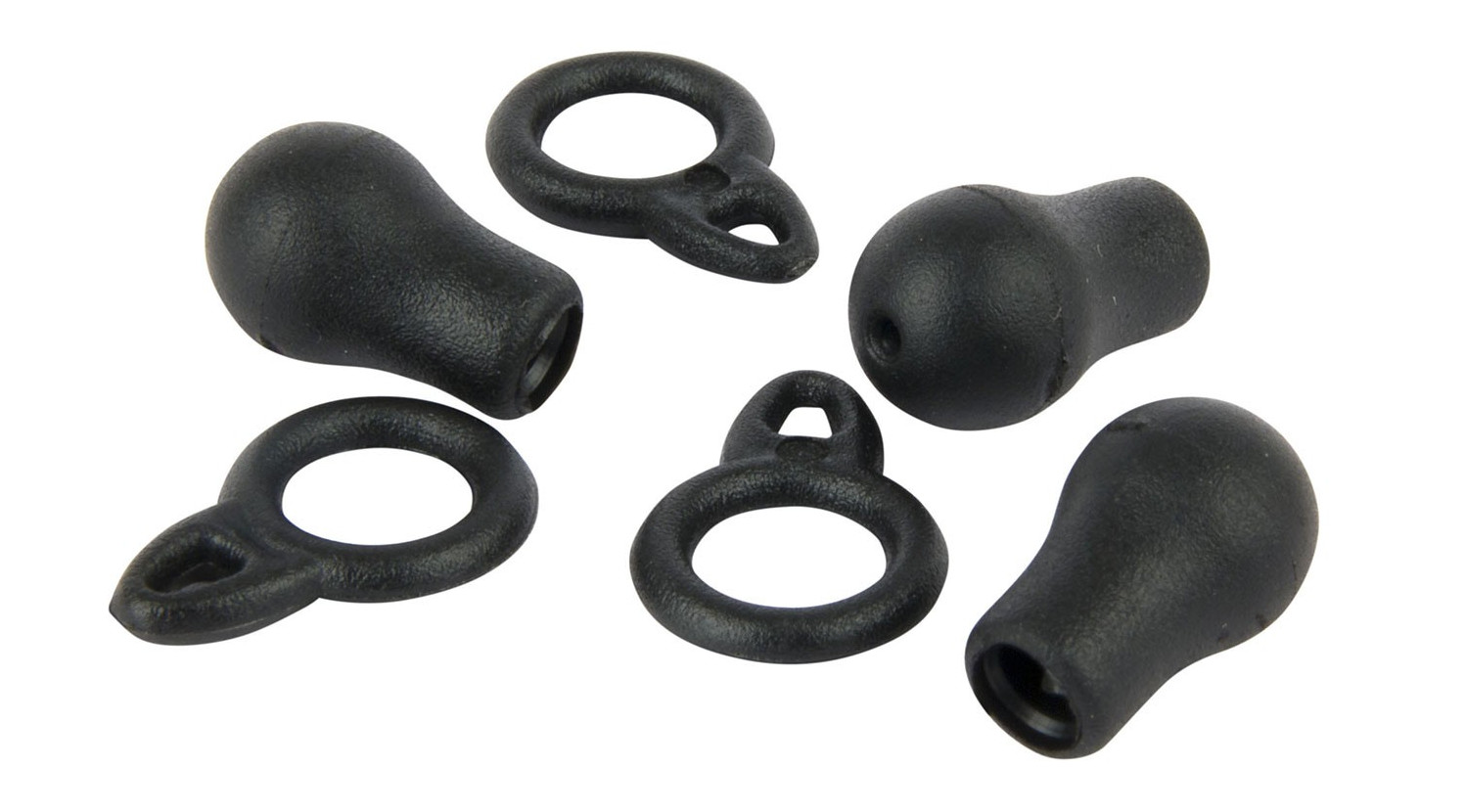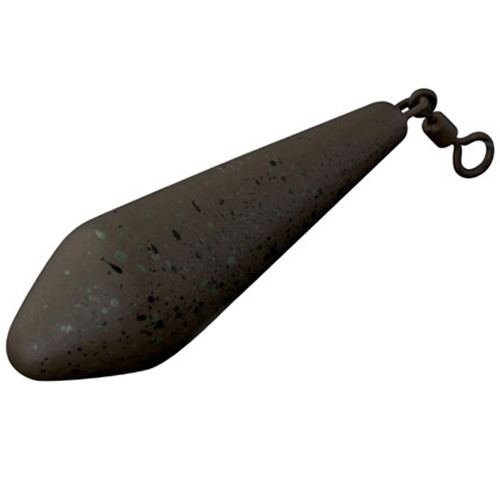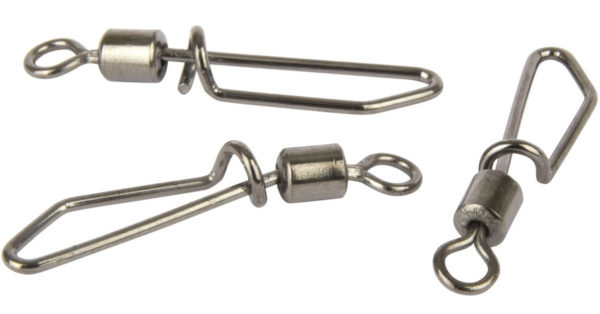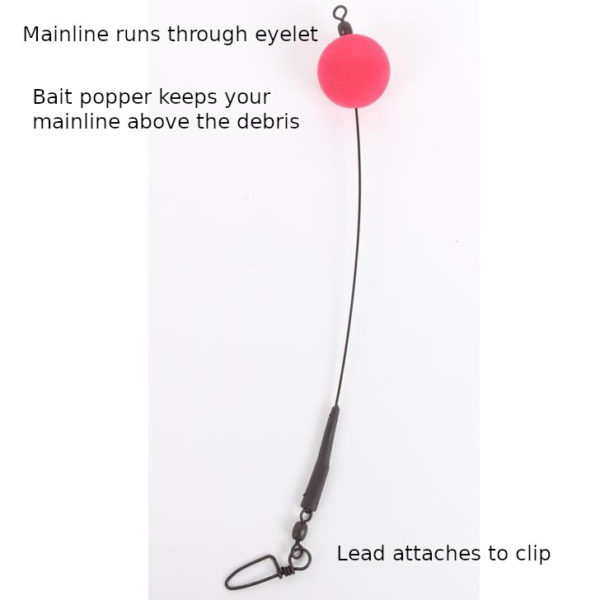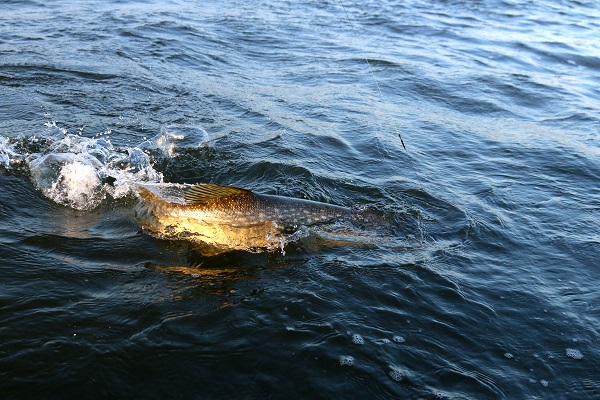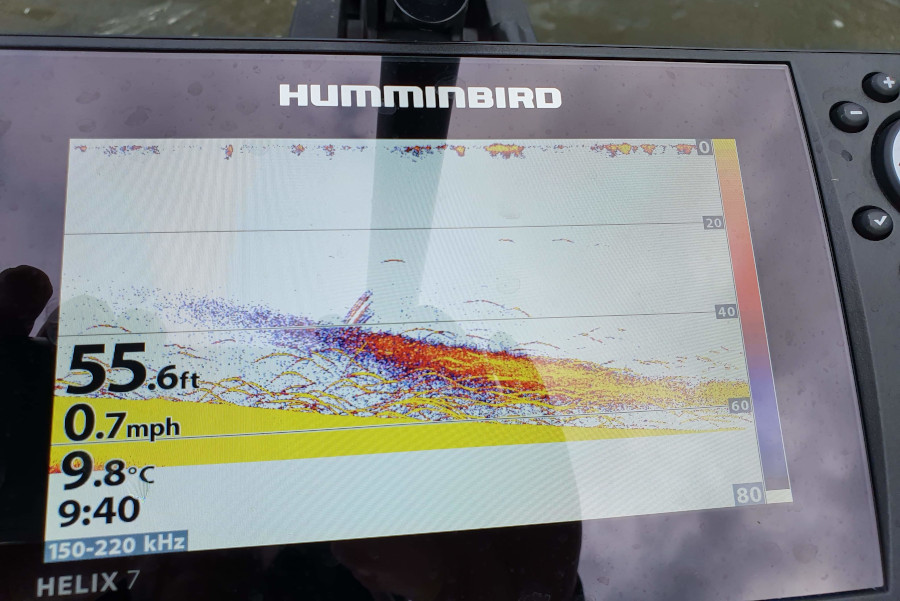The most commonly used bait fishing rig for pike is, without a doubt, the running ledger rig. This bait fishing rig is designed to fish a bait on the bottom of a lake or loch bed. The rig itself compromises of a run ring, buffer bead, quick-change link, a lead and a pike wire trace.
In this article, we will be explaining what each component is and how they work together to create this resistance free-running ledger rig.

Pike Terminal Tackle
Wire Trace
A wire trace is essential when fishing for pike to prevent them from biting through the trace. Wire traces should be a minimum of 30cm long, to keep the mainline well away from sharp teeth, and wire should be at least 30lb breaking strain.
Wire traces with two treble hooks are most popular with barbless or semi-barbed hooks. The treble closest to the mainline is hooked into the bait, normally the root of the tail when using whole dead baits or tail sections to provide a firm hold and take the strain from the cast. The top treble is lightly hooked under the skin of the bait. This allows the angler to strike out of the bait and transfer the hooks from the bait to the fish’s mouth on the strike. Barbless hooks make unhooking fish much quicker and easier although semi barbed treble, where two points are barbless and the third has a barb, can help baits stay on the hooks during casting. The barbed point is hooked into the bait, which helps to stop it from pulling free as easily on the cast but means it rarely hooks the fish.
Run Ring
The run ring runs on the mainline, its only job is to reduce any resistance when a pike picks up a bait and moves off with it. It allows the line to freely move through the run ring thanks to its oversized bore.

A run ring has a small eyelet located below the big bore. This is for attaching a lead clip/weak link. A lead clip is just a small metal clip that allows you to attach a lead easily to the run ring. However, we would recommend testing the breaking strain of these links. You want to have the ability to break free from the snap link if your lead becomes snagged on the bottom.
Weak Link
As we previously mentioned, having a weak link between your lead and run ring is important, especially if you’re fishing in areas that may have snags present. Using a cheap snap link is one option. However, we have a couple of alternative methods that you might consider using:
Paperclips
Yes, you read that correctly, they’re cheap as chips and can be straightened out with a bit of pressure. There is no issue with these straightening out on the initial cast as most pike rods come with a progressive action, so don’t load as quickly as faster action rods. If however, you do experience issues with the paperclip bending out, bend one end of the paperclip behind the preformed bend of the clip. This will stop the clip from straightening at all on the cast.
Mono Weak Link
This is an old school method but is still highly effective to this day. By taking a length of monofilament, ensure it is near twice the length of your trace to minimise the chances of it tangling when in flight. When casting the rig, the lead and bait should be pulling away from each other during the cast.
The weak link should be at least half the breaking strain of your mainline. This is so you can snap the mono weak link if the lead does become snagged.
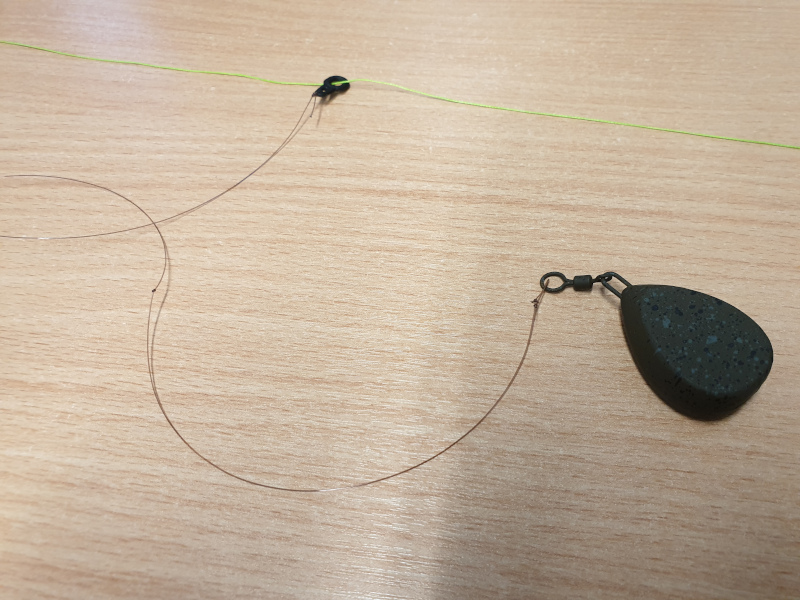
Top Tip: If you’re new to pike fishing, you may experience the run ring running back up the line during the cast. To eliminate this happening, simply feather the line with your forefinger, this slows the speed of the line and allows the lead to run back towards the buffer bead and trace. It’s important to have the run ring sitting as close to buffer bead as possible. We will explain why later in the article.
Buffer Bead
The buffer bead does exactly what it says, it acts as a buffer and has two jobs. One is to protect the knot on our mainline from being exposed to any damage by acting as a shock absorber and secondly, it stops the run ring passing down over our quick change link and onto our wire trace.
Remember we said we would come back to the point on having the run ring as close to the buffer bead as possible? Well, this is why, the lead is the anchor point of the rig itself, it’s incredibly important to ensure the line is tight to the lead and rig when fishing. The closer the lead is to the buffer bead and the trace, the better your bite detection will be.
This is because the anchor point is as close to the bait as it can be, so when a fish picks up a bait it only has to move the length of the trace before it reaches the anchor point and provides you with indication at the rod end.
If the lead is sitting further up the line, that increases the overall length a fish can move before the alarm will sound because we have increased the distance from the lead anchor point to the bait. So more movement is required before we are made aware that a pike has shown interest in our bait.
Leads
We recommend leads from 2oz up to 4 oz depending on your fishing conditions, bait size and overall fishing distance. For example, if you want to achieve distance, opt for a heavier lead and a smaller bait arrangement. This will balance the overall rig slightly better and a smaller bait is more aerodynamic.
Lead choice
With so many choices of lead shapes and weights on the market, an angler might think that any lead will do. To a point, this is true. However, each shaped lead has a unique design purpose that will aid your rig presentation.
We recommend two styles of leads to consider.
Distance
As the name suggests, the distance lead is designed to increase overall casting distance. Its aerodynamic bullet shape design allows it to cut through the air more efficiently. Distance leads are ideal for fishing over solid bottoms and are good for fishing on long and slow rising gradients or drop-offs.
Flat pear
With a flat pear profile shape, these leads don’t cast as well as distance leads, however, they lie better on soft or silt based bottoms. They also don’t roll on steep drop-offs, unlike distance leads. Meaning rig presentation is far superior in these instances as the flat pear design will not roll when presented on steeper drop-offs.
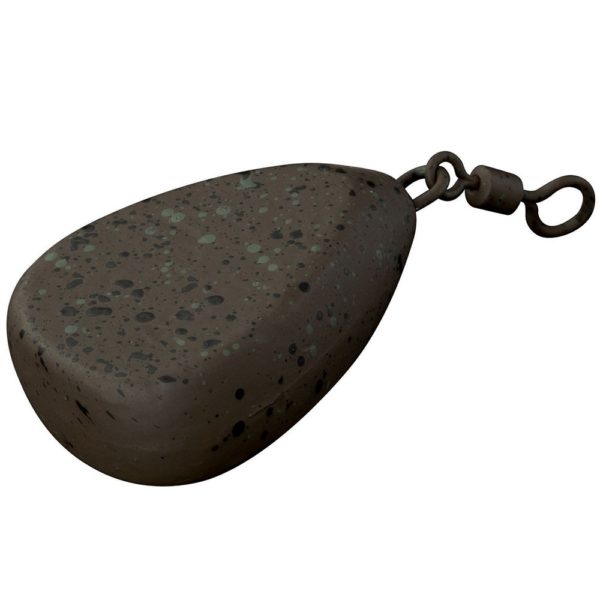
Quick Change Trace Link
Quick change trace clips allow you to clip and unclip the trace from the rig itself. This can be very advantageous. It allows you to replace a damaged trace quickly without having to dismantle the whole rig. It also allows you to detach the trace when you land a fish. Meaning you can deal with a fish easily without having to carry a pike rod around the bank as well as deal with a lively fish in the net or on an unhooking mat.
How to fish a running ledger rig
Cast the rig to your desired spot then feather the line just before the rig hits the water. This will ensure the rig lands perfectly and provides a better presentation.
Once the rig has hit the bottom, ensure your line has settled and reel down until the line is completely taut and you feel the weight of lead. It is important that the line is tight to the lead as your bite indication is extremely important as we want to eliminate the chances of deep hooking a fish.
Fishing over weedy lake/loch beds
If you’re fishing over a weed-based bottom, a standard running ledger rig might not be practical. This is because the run ring or lead may get caught up in weed and increase the resistance on your running ledger rig. In these circumstances, implementing a floating ledger stem will allow you to present a resistance-free rig on these types of bottoms. As the ledger stems buoyancy will help keep your mainline above the weedy areas.
So what is a ledger stem?
A ledger stem is basically a run ring that has a buoyancy aid attached directly below the run ring. The stem that the run ring is attached to is made up of either plastic tubing or wire. At the other end of this is a snap link for attaching your lead.
Summary
After reading this article, you should now have a better understanding of how to rig up and fish a running ledger rig for pike. If you would like to know how to make your own wire trace, check out our article here.


